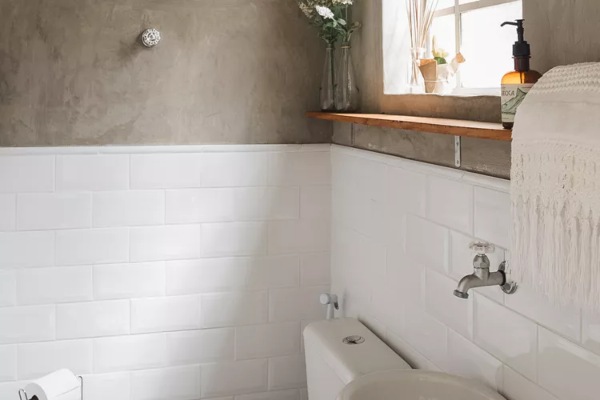Bathroom walls are totally different from walls in other parts of the home. In dry areas like bedrooms, living rooms, and hallways, any type of wall covering will do. But that is not the case for bathrooms. In bathrooms, water will enter from all directions. The bathroom walls tolerate so much from moisture from the direct tub and shower overspray and moisture-laden air. While bathroom vent fans help a bit, well-vented bathrooms can still face moisture issues.
Below, we have listed some of the best bathroom wall ideas to help you fight any moisture issues.
Types of Bathroom Wall Surfaces
Here are some of the types of wall surfaces for your bathroom walls.
Vinyl wallpaper
Pros
- Easy to install because it can be unpeeled and reapplied more than once
Cons
- Some vinyl wallpaper is not suited for heavy moisture
Interior paint
Pros
- Designated bathroom paint has mold- and mildew-inhibiting additives
Cons
- If designated bathroom paint is chosen, it can cost up to twice as much as regular interior paint
Tile
Pros
- Tile is 100 percent waterproof as long as it is expertly installed
Cons
- Too much tile can overwhelm a room and make it feel sterile
Beadboard
Pros
- Beadboard helps to protect walls against direct moisture from shower or bathtub
Cons
- Beadboard’s traditional look may not work for all bathroom styles
Tileboard
Pros
- Tileboard can be a quick fix for bad drywall in a kitchen or bathroom
Cons
- Medium-density fiberboard (MDF) with a hard melamine layer on top is a poor substitute for real tile
Best Materials for Bathroom Walls
Whether you’re building a new bathroom or remodeling your old one, the bathroom is always a top priority. As you’re thinking of the best material for your bathroom wall, do consider the daily wear in a bathroom. Your bathroom walls need to be strong enough to handle humidity and moisture, and they need to be easily wiped down and cleaned. The top key is water-resistant properties.
Also, Read Elevate Your Home Décor: Tips and Tricks for Using Gold Leaf DIY Trend
Vinyl Wallpaper
Vinyl-coated wallpaper is one of the best options for your bathroom walls in terms of functionality since most paper coverings will degrade in a prolonged moist environment. You must be thinking 100-percent vinyl wallpaper reminds you of a hotel. But that’s not true. Vinyl wallpaper has developed a lot and has become more sophisticated. Retailers like Tempaper offer gorgeous vinyl wallpapers that have graced homes featured in style and shelter magazines.
Be sure that your present wall surface can take peelable vinyl wallpaper. Since it is less sticky than permanent wallpaper, peelable vinyl wallpaper will not stick to matte, flat, or rough surfaces. Vinyl wallpaper best works for indirect, ambient moisture. So, you have to use it in conjunction with a surface that covers the lower part of the walls as well. Luckily, some vinyl wallpapers will stand direct water contact like in a shower stall.

One pro of vinyl wallpaper is that you can test it before you apply it to your bathroom walls. Purchase a roll or a sample and stick it up in the room. If it contains large patterns, they will visually reduce the size of your bathroom. While vertical patterns draw your eye upward and make the room look and feel taller, horizontals will make it look wide.
Semi-Gloss Bathroom or Regular Interior Paint
Bathroom paint is a type of interior paint that has special properties that make it suitable for bathrooms. Regular paint’s pores trap water so it is not that suitable for a wet area like a bathroom. One classic way to avoid this problem is to use semi-gloss or even a high gloss sheen; water beads up on these surfaces. However, premium paints that contain mold-killing additives let you have those desirable flatter sheens in the bathroom.
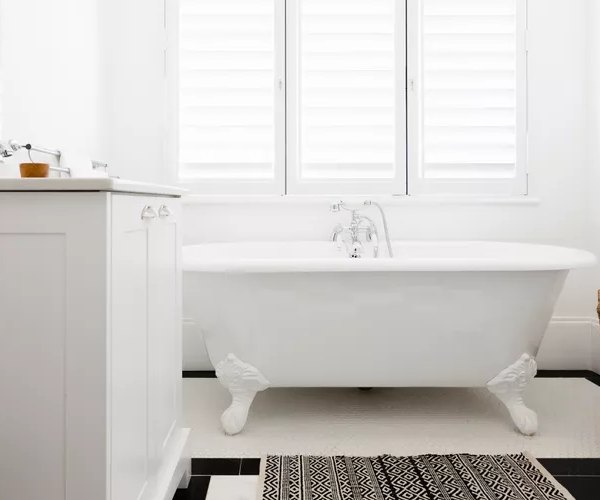
The most beneficial thing about using paint for your bathroom wall is its cost. Eggshell or semi-gloss interior paint is not that expensive. Not only that. Even designated bathroom paint which can cost up to twice the amount of regular acrylic-latex interior paint, is far cheaper than using wallpaper, tile, or other hard surfaces.
Ceramic or Glass Tile
Ceramic tile is a classic option for bathroom walls. If the tiles are properly applied, you will never face moisture problems. Tiles have been used for even standing water surfaces like the insides of bathtubs and pools since the days of the ancient Romans.
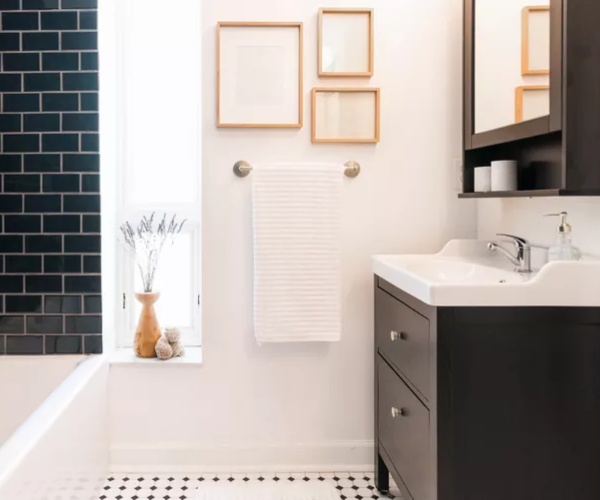
Design is your main focus. Tiles have grout, and grout means lines. Lines make patterns that can either beautify or detract from a bathroom’s personality. Too many tiles can make your bathroom look busy and even depressing. That is why we recommend partially tiling your bathroom wall. Ceramic tile which is used as a wainscot normally stops at a certain point on the wall, around 36 inches.
Beadboard
Beadboard gives only some coverage for the wall mostly the lower half. And the lower half part is the most necessary part when dealing with moisture problems. You can paint your beadboard with semi-gloss or even glossy paint, which helps protect the lower parts of the walls against water and moisture.
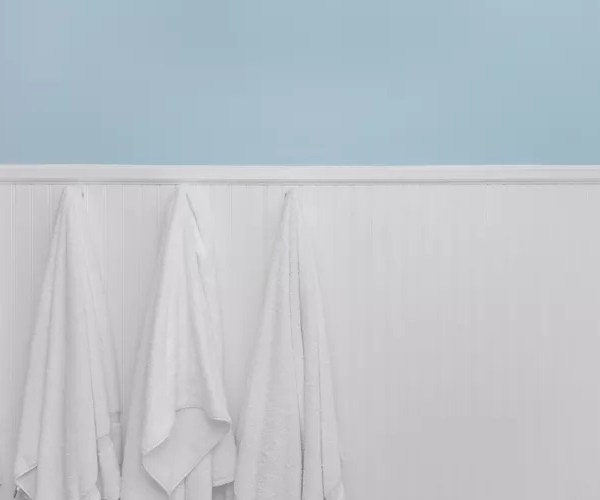
To make installation super easy, buy panels of beadboard that are eight feet long by four feet high. If installed lengthwise, these boards lay down quickly with construction glue and finish nails. For a more polished look, choose individual beadboard planks.
Beadboard gives your bathroom a classy look, especially for traditionally styled bathrooms, beadboards just fit in. For modern bathrooms, the beadboard is out of place.
Tileboard
At first sight, tileboard looks like ceramic tile but they are not the same. Tileboard comes in large format panels that let you install 32 square feet of wall covering that looks nominally like tile in a little time.
Better tileboard looks similar to real ceramic tile and the worn surface is coated, so it doesn’t let moisture get to it. Tileboard is cheap and easy to install and it is best when used for a guest bathroom or basement bathroom due to its economical appearance. Along with fixing wall problems quickly, tileboard also adds a little extra long-term value to your home.
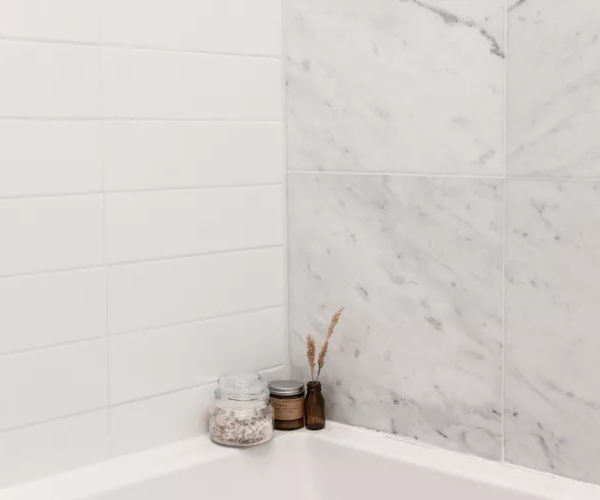
One con of tileboard is that it quickly swells up and if the water reaches the back of it, it will not recover its original dimensions. You can avoid this problem by keeping all seams and edges caulked with bathroom-grade silicone caulk.
How to maintain your bathroom walls
No matter what material you use on your bathroom walls, keeping them clean is a big part of your regular bathroom maintenance. Wipe them down on a regular basis to prevent dust and hair from accumulating in bathrooms. Whenever you deep clean your bathroom, clean them as well. You can use a cleaning solution that is safe for your specific wall material to prevent it from molding.
FAQs
Q: What is the best material for bathroom walls?
A: While several water-resistant options will hold up in a bathroom, experts agree that porcelain, ceramic, or glass tile are the best options for bathroom walls.
Q: What sheeting is best for bathroom walls?
A: You can use acrylic sheeting on your bathroom walls for a durable, cost-effective option.
Q: What is the cheapest option for bathroom walls?
A: The cheapest option is simply to paint your bathroom walls! Choose a semi-gloss paint for a finish that stands up to moisture and is easy to clean.
Also, Read Top 10 Poisonous Plants to Keep Out of Your Garden for Dog’s Safety
